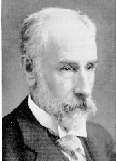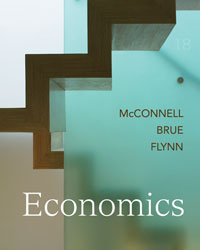Economics (McConnell), 18th EditionChapter 7:
Consumer Behavior (+ Appendix)Origin of the Idea <a onClick="window.open('/olcweb/cgi/pluginpop.cgi?it=gif::::/sites/dl/free/0025694212/124310/origins_image.gif','popWin', 'width=70,height=90,resizable,scrollbars');" href="#"><img valign="absmiddle" height="16" width="16" border="0" src="/olcweb/styles/shared/linkicons/image.gif"> (1.0K)</a> <a onClick="window.open('/olcweb/cgi/pluginpop.cgi?it=gif::::/sites/dl/free/0025694212/124310/origins_image.gif','popWin', 'width=70,height=90,resizable,scrollbars');" href="#"><img valign="absmiddle" height="16" width="16" border="0" src="/olcweb/styles/shared/linkicons/image.gif"> (1.0K)</a> | 7.1 Diminishing Marginal Utility |  <a onClick="window.open('/olcweb/cgi/pluginpop.cgi?it=gif::::/sites/dl/free/0025694212/124310/origins_image.gif','popWin', 'width=70,height=90,resizable,scrollbars');" href="#"><img valign="absmiddle" height="16" width="16" border="0" src="/olcweb/styles/shared/linkicons/image.gif"> (1.0K)</a> <a onClick="window.open('/olcweb/cgi/pluginpop.cgi?it=gif::::/sites/dl/free/0025694212/124310/origins_image.gif','popWin', 'width=70,height=90,resizable,scrollbars');" href="#"><img valign="absmiddle" height="16" width="16" border="0" src="/olcweb/styles/shared/linkicons/image.gif"> (1.0K)</a> | 7.2 Income and Substitution Effects |  <a onClick="window.open('/olcweb/cgi/pluginpop.cgi?it=gif::::/sites/dl/free/0025694212/124310/origins_image.gif','popWin', 'width=70,height=90,resizable,scrollbars');" href="#"><img valign="absmiddle" height="16" width="16" border="0" src="/olcweb/styles/shared/linkicons/image.gif"> (1.0K)</a> <a onClick="window.open('/olcweb/cgi/pluginpop.cgi?it=gif::::/sites/dl/free/0025694212/124310/origins_image.gif','popWin', 'width=70,height=90,resizable,scrollbars');" href="#"><img valign="absmiddle" height="16" width="16" border="0" src="/olcweb/styles/shared/linkicons/image.gif"> (1.0K)</a> | 7.3 Diamond-Water Paradox |  <a onClick="window.open('/olcweb/cgi/pluginpop.cgi?it=gif::::/sites/dl/free/0025694212/124310/origins_image.gif','popWin', 'width=70,height=90,resizable,scrollbars');" href="#"><img valign="absmiddle" height="16" width="16" border="0" src="/olcweb/styles/shared/linkicons/image.gif"> (1.0K)</a> <a onClick="window.open('/olcweb/cgi/pluginpop.cgi?it=gif::::/sites/dl/free/0025694212/124310/origins_image.gif','popWin', 'width=70,height=90,resizable,scrollbars');" href="#"><img valign="absmiddle" height="16" width="16" border="0" src="/olcweb/styles/shared/linkicons/image.gif"> (1.0K)</a> | 7.4 Indifference Curves |
 <a onClick="window.open('/olcweb/cgi/pluginpop.cgi?it=gif::::/sites/dl/free/0025694212/124310/origins_image.gif','popWin', 'width=70,height=90,resizable,scrollbars');" href="#"><img valign="absmiddle" height="16" width="16" border="0" src="/olcweb/styles/shared/linkicons/image.gif"> (1.0K)</a> <a onClick="window.open('/olcweb/cgi/pluginpop.cgi?it=gif::::/sites/dl/free/0025694212/124310/origins_image.gif','popWin', 'width=70,height=90,resizable,scrollbars');" href="#"><img valign="absmiddle" height="16" width="16" border="0" src="/olcweb/styles/shared/linkicons/image.gif"> (1.0K)</a> | 7.1 Diminishing Marginal Utility |
Many prominent economists have contributed to the development and use of the concept of diminishing marginal utility. The first was Jeremy Bentham (1748-1832). Bentham, an Englishman, studied history and Latin at the age of four, entered Queen's College in Oxford when he was 12, and graduated at 15. He then went on to study law, at the behest of his father, but quickly moved on to a more scholarly life. Bentham saw people as machines designed to maximize pleasure and minimize pain. To that end, and in support for scientific advancement in general, he advocated anatomical research on cadavers at a time when such practices were viewed, at the very least, as distasteful and immoral. Bentham donated his own body for dissection, largely to promote acceptance of the practice. This, however, was not the end of Jeremy Bentham. He also left his estate to University College, London, but under the condition that his remains be present at all board meetings. His padded and dressed skeleton still sits (in a glass case) at the college. A wax head sits atop the body, and his actual head was preserved using South American headhunting techniques. Bentham's real head used to sit on a plate between his feet, but in recent years has been relocated to a safe at the college, presumably to protect it from would-be pranksters using it on the soccer pitch or in other unspeakable ways.
Bentham applied the notion of diminishing marginal utility to happiness derived from wealth. Bentham wrote:
"Of two people having unequal fortunes, he who has most wealth must by a legislator be regarded as having most happiness. But the quantity of happiness will not go on increasing in anything near the same proportion as the quantity of wealth:--ten thousand times the quantity of wealth will not bring with it ten thousand times the quantity of happiness. It will even be matter of doubt, whether ten thousand times the wealth will in general bring with it twice the happiness. The effect of wealth in the production of happiness goes on diminishing, as the quantity by which the wealth of one man exceeds that of another goes on increasing: in other words, the quantity of happiness produced by a particle of wealth (each particle being of the same magnitude) will be less at every particle; the second will produce less than the first, the third than the second, and so on."(1)
Jules Dupuit (1804-1866), a French engineer, applied the concept of diminishing marginal utility to the consumption of water. He argued that people use water for highest value uses first, such as drinking, and then use it for less valuable uses (agriculture, bathing, fountains) as water becomes more plentiful. Dupuit used this idea to create "curves of consumption," where, because of diminishing marginal utility, people would be willing to purchase more if the price were lowered. This, of course, describes what we now call a demand curve.
Born in Fossano, Piedmont, Italy (then part of the French empire), Dupuit moved to Paris with his parents in 1814. He studied in Versailles, Louis-le-Grand and Saint Louis, eventually earning his degree in engineering from Ecole des Ponts et Chaussees. Dupuit became a prominent engineer in France, receiving the French Legion of Honor in 1843, becoming the chief engineer in Paris in 1850, and earning the position of inspector-general of the French Corps of Civil Engineers in 1855. From 1844 to 1853, Dupuit published numerous works in economics, his "hobby," contributing to the theories of utility, consumer surplus and price discrimination.
While Dupuit was in France formulating his ideas on utility, Herman Heindrich Gossen (1810-1858) spent four years in seclusion in Germany developing his own. Gossen developed two laws of utility, the first being the law of diminishing returns. Gossen's law of diminishing returns applied to consumption, unlike the modern definition that applied to production. Gossen was clearly referring to what we call diminishing marginal utility, and he used his theory to demonstrate how exchange can increase satisfaction for both parties. |  <a onClick="window.open('/olcweb/cgi/pluginpop.cgi?it=jpg::::/sites/dl/free/0025694212/124320/origin21_2.jpg','popWin', 'width=303,height=454,resizable,scrollbars');" href="#"><img valign="absmiddle" height="16" width="16" border="0" src="/olcweb/styles/shared/linkicons/image.gif"> (43.0K)</a> <a onClick="window.open('/olcweb/cgi/pluginpop.cgi?it=jpg::::/sites/dl/free/0025694212/124320/origin21_2.jpg','popWin', 'width=303,height=454,resizable,scrollbars');" href="#"><img valign="absmiddle" height="16" width="16" border="0" src="/olcweb/styles/shared/linkicons/image.gif"> (43.0K)</a> |
Gossen was the only son of three children, born to the devoutly Catholic Joseph and Mechtildes Gossen. He excelled in mathematics, studied law and public administration, and followed in his father's footsteps to become a civil servant. Following his father's death, Gossen took his inheritance, left public life, and wrote The Laws of Human Relations and the Rules of Human Action Derived Therefrom. Disheartened by the lack of public interest in his book, Gossen requested that it be withdrawn from circulation.
In 1871, English economist William Stanley Jevons applied the idea of diminishing marginal utility to the work decision, arguing that the marginal utility of the money earned for each hour of work decreases as the day progresses, and the disutility (pain) from working increases as each additional hour is worked. According to Jevons, a person will choose to work up to the point where the marginal utility of earnings (or the marginal benefit) equals the marginal disutility (or marginal cost) of work. In formulating this theory, Jevons did recognize that workers cannot always choose how many hours they can work at a particular job.
The concept of diminishing marginal utility has a long intellectual history, and is an integral part of modern economic theory.
- W. Stark, Jeremy Bentham's Economic Writings, 3 vols. (New York: Franklin, 1952), 1: 113.
Photograph courtesy of: (c)Nance Trueworthy
 <a onClick="window.open('/olcweb/cgi/pluginpop.cgi?it=gif::::/sites/dl/free/0025694212/124310/origins_image.gif','popWin', 'width=70,height=90,resizable,scrollbars');" href="#"><img valign="absmiddle" height="16" width="16" border="0" src="/olcweb/styles/shared/linkicons/image.gif"> (1.0K)</a> <a onClick="window.open('/olcweb/cgi/pluginpop.cgi?it=gif::::/sites/dl/free/0025694212/124310/origins_image.gif','popWin', 'width=70,height=90,resizable,scrollbars');" href="#"><img valign="absmiddle" height="16" width="16" border="0" src="/olcweb/styles/shared/linkicons/image.gif"> (1.0K)</a> | 7.2 Income and Substitution Effects |
The substitution effect was first articulated by Alfred Marshall (1842-1924), the leading figure in neoclassical economics, as part of his explanation for the law of demand. Marshall recognized that changes in relative prices would lead consumers to substitute in consumption, but he failed to recognize that price changes would affect overall purchasing power (what we call the income effect).
Articulation of the income effect would come years later from Sir John R. Hicks (1904-1989). Hicks studied politics, philosophy, and economics at Oxford, and went on to teach at the London School of Economics, Manchester University, and Oxford. Hicks made numerous contributions to the field of economics, including the application of indifference curves and budget lines to demand theory. He also furthered the development of wage and production theory, and, in the area of macroeconomics, expanded upon the works of Leon Walras and John Maynard Keynes. For his contributions to economics, Hicks was knighted in 1964 and received the Nobel Prize in economics in 1972.
|  <a onClick="window.open('/olcweb/cgi/pluginpop.cgi?it=jpg::::/sites/dl/free/0025694212/124320/origin21_1.jpg','popWin', 'width=434,height=323,resizable,scrollbars');" href="#"><img valign="absmiddle" height="16" width="16" border="0" src="/olcweb/styles/shared/linkicons/image.gif"> (67.0K)</a> <a onClick="window.open('/olcweb/cgi/pluginpop.cgi?it=jpg::::/sites/dl/free/0025694212/124320/origin21_1.jpg','popWin', 'width=434,height=323,resizable,scrollbars');" href="#"><img valign="absmiddle" height="16" width="16" border="0" src="/olcweb/styles/shared/linkicons/image.gif"> (67.0K)</a> |
Photograph courtesy of: (c)Nance Trueworthy.
 <a onClick="window.open('/olcweb/cgi/pluginpop.cgi?it=gif::::/sites/dl/free/0025694212/124310/origins_image.gif','popWin', 'width=70,height=90,resizable,scrollbars');" href="#"><img valign="absmiddle" height="16" width="16" border="0" src="/olcweb/styles/shared/linkicons/image.gif"> (1.0K)</a> <a onClick="window.open('/olcweb/cgi/pluginpop.cgi?it=gif::::/sites/dl/free/0025694212/124310/origins_image.gif','popWin', 'width=70,height=90,resizable,scrollbars');" href="#"><img valign="absmiddle" height="16" width="16" border="0" src="/olcweb/styles/shared/linkicons/image.gif"> (1.0K)</a> | 7.3 Diamond-Water Paradox |
The original statement of the diamond-water paradox comes from Adam Smith (1723-1790). The paradox arose in Smith's discussion of value.
The word VALUE, it is to be observed, has two different meanings, and sometimes expresses the utility of some particular object, and sometimes the power of purchasing other goods which the possession of that object conveys. The one may be called "value in use"; the other, "value in exchange." The things which have the greatest value in use have frequently little or no value in exchange; those which have the greatest value in exchange have frequently little or no use value. Nothing is more useful than water: but it will purchase scarce any thing; scarce any thing can be had in exchange for it. A diamond, on the contrary, has scarce any value in use; but a very great quantity of other goods may frequently be had in exchange for it.(1)
Smith recognized the paradox, but did not solve it. The solution would come nearly 100 years later with the English economist William Stanley Jevons (1835-1882). As explained in your text, the paradox is solved by looking at the marginal utilities of the last units of diamonds and water, not total utility. As Jevons explained:
We shall seldom need to consider the degree of utility except as regards the last increment which has been consumed, or, which comes to the same thing, the next increment which is about to be consumed. I shall therefore commonly use the expression final degree of utility, as meaning the degree of utility of the last addition, or the next possible addition of a very small, or infinitely small, quantity to the existing stock.(2) |
 <a onClick="window.open('/olcweb/cgi/pluginpop.cgi?it=jpg::::/sites/dl/free/0025694212/124320/origin21_3.jpg','popWin', 'width=380,height=287,resizable,scrollbars');" href="#"><img valign="absmiddle" height="16" width="16" border="0" src="/olcweb/styles/shared/linkicons/image.gif"> (43.0K)</a> <a onClick="window.open('/olcweb/cgi/pluginpop.cgi?it=jpg::::/sites/dl/free/0025694212/124320/origin21_3.jpg','popWin', 'width=380,height=287,resizable,scrollbars');" href="#"><img valign="absmiddle" height="16" width="16" border="0" src="/olcweb/styles/shared/linkicons/image.gif"> (43.0K)</a> |
During his relatively short life, Jevons worked as an assayer in the mint in Australia, studied political economy at University College, London, published works on logic and political economy, and became professor of logic, political economy and philosophy in Manchester and University College, London. His interest in logic led Jevons to invent a logic machine, which he presented before the Royal Society in 1870. In addition to his theoretical work in economics, Jevons also contributed to the development of index numbers, which today are critical to assessing economic welfare and conducting meaningful economic research. Jevons drowned at the age of 47, ironically while swimming at a health resort.
- Adam Smith, An Inquiry into the Nature and Causes of the Wealth of Nations, (New York: G.P. Putnam's Sons, 1877), p. 37 [Originally published in 1776.]
- William Stanley Jevons, The Theory of Political Economy, 3d ed. (London: Macmillan, 1888), p. 51 [Originally published in 1871.]
Photograph courtesy of: (c)Nance Trueworthy
 <a onClick="window.open('/olcweb/cgi/pluginpop.cgi?it=gif::::/sites/dl/free/0025694212/124310/origins_image.gif','popWin', 'width=70,height=90,resizable,scrollbars');" href="#"><img valign="absmiddle" height="16" width="16" border="0" src="/olcweb/styles/shared/linkicons/image.gif"> (1.0K)</a> <a onClick="window.open('/olcweb/cgi/pluginpop.cgi?it=gif::::/sites/dl/free/0025694212/124310/origins_image.gif','popWin', 'width=70,height=90,resizable,scrollbars');" href="#"><img valign="absmiddle" height="16" width="16" border="0" src="/olcweb/styles/shared/linkicons/image.gif"> (1.0K)</a> | 7.4 Indifference Curves |
Francis Ysidro Edgeworth (1845-1926) introduced indifference curves in 1881 in his book Mathematical Psychics. Born in Ireland, Edgeworth studied at Trinity College in Dublin and at Oxford. He spent his career as the Tooke professor of political economy at Oxford while also serving as the editor of the Economic Journal, president of the Statistical Society, and as a fellow of the British Academy. In his work as an economist, Edgeworth is recognized as one of the pioneers in applying mathematics to formulate and test economic theories.
The indifference curves appearing in the appendix show a single consumer's preferences between two goods. Edgeworth used two individuals, each with a good to exchange. He used his indifference curves to identify combinations of goods that two individuals would exchange with each other in order to maximize utility.
Edgeworth's indifference curves were reconstructed into their modern version by Vilfredo Pareto (1848-1923). Born in Paris to Italian parents, Pareto studied mathematics, physics, and engineering at the University of Turin in Italy. He spent time as the director of the Italian railway, but in 1893 replaced Leon Walras as the chair of political economy at the University of Lausanne in Switzerland. Building on the general equilibrium model of Walras, Pareto demonstrated conditions under which no one in the economy could be made better off without making someone else worse off. This condition is today referred to as Pareto Optimality.
|  <a onClick="window.open('/olcweb/cgi/pluginpop.cgi?it=jpg::::/sites/dl/free/0025694212/124320/origin21_4.jpg','popWin', 'width=166,height=231,resizable,scrollbars');" href="#"><img valign="absmiddle" height="16" width="16" border="0" src="/olcweb/styles/shared/linkicons/image.gif"> (24.0K)</a> <a onClick="window.open('/olcweb/cgi/pluginpop.cgi?it=jpg::::/sites/dl/free/0025694212/124320/origin21_4.jpg','popWin', 'width=166,height=231,resizable,scrollbars');" href="#"><img valign="absmiddle" height="16" width="16" border="0" src="/olcweb/styles/shared/linkicons/image.gif"> (24.0K)</a> |
Using indifference curves and budget lines to derive demand curves was the brainchild of Sir John R. Hicks (1904-1989). Hicks studied politics, philosophy, and economics at Oxford, and went on to teach at the London School of Economics, Manchester University, and Oxford. Hicks made numerous contributions to the field of economics, including the development of the income and substitution effects that economists use to explain the law of demand. In fact, he used budget lines and indifference curves to separate the income and substitution effects that occur when price changes. Hicks also furthered the development of wage and production theory, and, in the area of macroeconomics, expanded upon the works of Leon Walras and John Maynard Keynes. For his contributions to economics, Hicks was knighted in 1964 and received the Nobel Prize in economics in 1972.
Photograph courtesy of: Cambridge University Press 1985, Mark Blaug, Great Economists Before Keynes  |  |





















